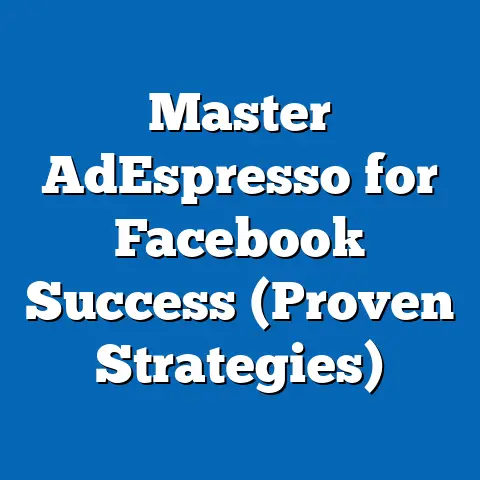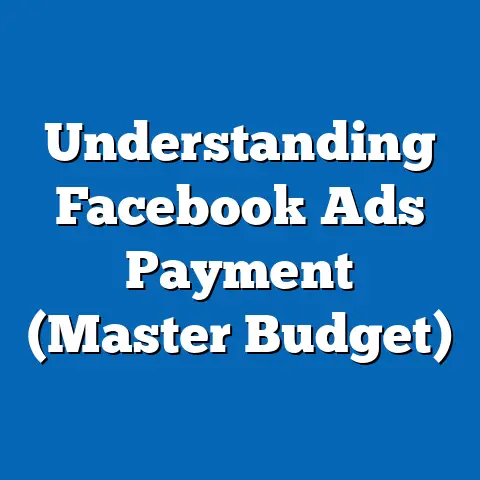Maximize Reach with Multilingual Facebook Ads (Proven Strategies)
As the leaves change and pumpkin spice lattes reappear, or as beach vacations give way to back-to-school shopping, one thing becomes undeniably clear: seasonal marketing is in full swing. These periods, brimming with heightened consumer engagement and emotion, are prime opportunities for brands to connect with audiences on a deeper level. The holiday season alone sees a massive surge in online shopping, with consumers actively seeking deals and gifts for loved ones. Back-to-school season witnesses parents and students alike gearing up for the academic year, creating a flurry of purchases across various categories. Tapping into these seasonal impulses can significantly boost your marketing ROI, but reaching the right audience with the right message is paramount.
Understanding the Multilingual Market
The world is increasingly interconnected, and your customer base likely reflects this reality. Ignoring the multilingual market is not just a missed opportunity; it’s a strategic disadvantage. Consider this: according to recent studies, over 70% of internet users are non-native English speakers. That’s a massive audience segment that you could be overlooking. Moreover, bilingual consumers often have higher buying power and are more likely to engage with brands that communicate with them in their native language.
One of my most memorable experiences involved working with a small e-commerce business that sold handcrafted jewelry. Initially, their Facebook ads were exclusively in English, targeting a broad audience in North America. While they saw some success, their growth plateaued. After researching their customer demographics, we discovered a significant portion of their customer base was Spanish-speaking. We decided to launch a Spanish-language campaign, translating their ad copy and creating culturally relevant visuals. The results were astonishing. Within weeks, their website traffic from Spanish-speaking users increased by 40%, and their sales in that segment nearly doubled.
Cultural relevance is another critical factor to consider. Simply translating your ad copy isn’t enough; you need to adapt your messaging to resonate with the cultural nuances of your target audience. For example, a campaign promoting a “summer sale” might need to be adjusted for different regions, taking into account varying climates and cultural traditions. Brands that have successfully localized their ads for different regions often see higher engagement and conversion rates. McDonald’s, for instance, tailors its menu and marketing messages to local tastes in different countries, ensuring that its brand resonates with diverse cultures. Understanding and respecting these cultural nuances can make or break your multilingual Facebook ad campaigns.
Takeaway: Recognizing the importance of the multilingual market and understanding cultural relevance is the first step towards crafting successful multilingual Facebook ads.
Crafting Multilingual Facebook Ads
Creating effective multilingual Facebook ads goes beyond simple translation. It involves careful consideration of language selection, ad copy best practices, and visual elements. Here’s how to approach each aspect:
Language Selection
Choosing the right languages to target is crucial. Start by analyzing your existing customer data to identify the languages spoken by your customer base. Tools like Google Analytics and Facebook Insights can provide valuable insights into your audience’s language preferences. Market research can also help you identify potential new markets to target. Consider factors such as the size of the market, the level of competition, and the potential ROI.
For example, if you’re selling products in the United States, targeting Spanish speakers is often a smart move, given the large Hispanic population. Similarly, if you’re expanding into Europe, consider targeting languages such as French, German, and Italian, depending on your product and target audience.
Ad Copy Best Practices
Writing effective ad copy in multiple languages requires more than just a translation tool. I’ve learned this the hard way. Early in my career, I relied heavily on automated translation services for my multilingual campaigns. While the translations were technically accurate, they lacked the nuance and cultural sensitivity needed to truly resonate with the audience. The result was lower engagement and conversion rates.
The key is to hire native speakers or professional translators who understand the cultural context of your target audience. They can adapt your messaging to ensure it’s not only accurate but also engaging and persuasive. Consider using transcreation, a process that goes beyond translation to recreate the intent, style, and tone of your original message in the target language.
Here are a few tips for writing effective multilingual ad copy:
- Keep it concise: Shorter ad copy is easier to translate and understand.
- Use simple language: Avoid complex jargon or idioms that might not translate well.
- Focus on benefits: Highlight the benefits of your product or service rather than just features.
- Include a clear call to action: Tell your audience exactly what you want them to do.
- Test different versions: A/B test different ad copy variations to see what resonates best with your audience.
Visual Elements
Visuals play a crucial role in ad effectiveness, especially in multilingual campaigns. Images and videos should be culturally relevant and resonate with your target audience. Avoid using images that might be offensive or inappropriate in certain cultures.
For example, a campaign featuring images of people celebrating Christmas might not be appropriate for targeting audiences in countries with different religious traditions. Similarly, images of food should reflect the culinary preferences of your target audience.
Consider using visuals that are universally appealing, such as images of nature, animals, or abstract designs. You can also use visuals that showcase the diversity of your target audience, featuring people of different ethnicities and backgrounds.
Takeaway: Crafting effective multilingual Facebook ads requires careful consideration of language selection, ad copy best practices, and visual elements.
Targeting and Audience Segmentation
Once you’ve crafted your multilingual ad copy and visuals, the next step is to target the right audience. Facebook offers a range of targeting options that allow you to reach specific demographics, interests, and behaviors.
Facebook’s Targeting Options
Facebook’s language targeting feature allows you to target users based on the languages they speak. This is a crucial tool for multilingual campaigns, as it ensures that your ads are shown to users who are most likely to understand them.
In addition to language targeting, you can also use location targeting to reach users in specific countries or regions. This is particularly useful if you’re running a campaign that’s specific to a certain location.
You can also target users based on their interests, behaviors, and demographics. For example, you can target users who are interested in travel, fashion, or technology. You can also target users based on their age, gender, education, and income.
Creating Audience Segments
Creating audience segments based on language preferences and cultural backgrounds is essential for maximizing the effectiveness of your multilingual campaigns. Facebook Insights can provide valuable insights into your audience’s behavior, allowing you to create highly targeted segments.
Here’s a step-by-step guide on how to create audience segments:
- Define your target audience: Start by identifying the key characteristics of your target audience, such as their age, gender, location, language, and interests.
- Use Facebook Insights: Use Facebook Insights to gather data about your audience’s behavior, such as their likes, interests, and purchase history.
- Create custom audiences: Create custom audiences based on your target audience’s characteristics and behavior.
- Use lookalike audiences: Use lookalike audiences to reach new users who are similar to your existing customers.
- Test different segments: A/B test different audience segments to see which ones perform best.
I once worked on a campaign for a travel agency that specialized in adventure tours. We created separate audience segments for English, Spanish, and French speakers, targeting users who were interested in outdoor activities and travel. We also created lookalike audiences based on our existing customer base. By targeting these highly specific segments, we were able to increase our conversion rates by 30%.
Takeaway: Effective targeting and audience segmentation are crucial for maximizing the reach and effectiveness of your multilingual Facebook ads.
Measuring Success and Optimizing Campaigns
Measuring the success of your multilingual Facebook ad campaigns is essential for ensuring that you’re getting the best possible ROI. By tracking key performance indicators (KPIs) and analyzing performance data, you can identify areas for improvement and optimize your campaigns for continuous improvement.
Key Performance Indicators (KPIs)
Here are some of the key performance indicators (KPIs) to track for your multilingual campaigns:
- Click-through rate (CTR): The percentage of users who click on your ad.
- Conversion rate: The percentage of users who take the desired action, such as making a purchase or filling out a form.
- Cost per conversion: The cost of acquiring a new customer.
- Return on ad spend (ROAS): The amount of revenue generated for every dollar spent on advertising.
- Engagement rate: The percentage of users who interact with your ad, such as liking, commenting, or sharing.
Tracking these KPIs will give you a clear picture of how your multilingual campaigns are performing and help you identify areas for improvement.
A/B Testing
A/B testing is a powerful tool for optimizing your multilingual Facebook ads. By testing different versions of your ads, you can determine which ones resonate best with your audience and drive the most conversions.
Here are some examples of what to test:
- Ad copy: Test different headlines, body text, and calls to action.
- Visuals: Test different images and videos.
- Targeting: Test different audience segments.
- Placement: Test different ad placements, such as the Facebook News Feed, Instagram Feed, and Audience Network.
I always recommend starting with one or two key variables to test at a time. For instance, you might test two different headlines while keeping everything else constant. This allows you to isolate the impact of that specific element on your ad’s performance.
Iterating Based on Data
Analyzing performance data and making informed adjustments to ongoing campaigns is crucial for continuous improvement. Use the data you collect from your KPIs and A/B tests to identify areas for improvement and optimize your campaigns accordingly.
For example, if you notice that your CTR is low for a particular ad, try testing different headlines or visuals. If your conversion rate is low, try optimizing your landing page or simplifying the checkout process.
I once worked on a campaign for a language learning app. We noticed that our conversion rates were significantly lower for our Spanish-language ads compared to our English-language ads. After analyzing the data, we discovered that our Spanish-language landing page was not optimized for mobile devices. We optimized the landing page for mobile, and our conversion rates increased by 50%.
Takeaway: Measuring success and optimizing campaigns through A/B testing and data analysis are essential for maximizing the ROI of your multilingual Facebook ads.
Conclusion
In today’s globalized world, multilingual Facebook ads are no longer a luxury; they’re a necessity for brands looking to maximize their reach and drive conversions, especially during critical seasonal campaigns. By understanding the importance of the multilingual market, crafting effective multilingual ads, targeting the right audience, and measuring your success, you can unlock the potential of a global customer base.
Remember the key strategies we’ve discussed:
- Understand your audience: Research their language preferences and cultural nuances.
- Craft compelling ad copy: Use native speakers or professional translators to ensure accuracy and cultural relevance.
- Choose relevant visuals: Use images and videos that resonate with your target audience.
- Target the right audience: Use Facebook’s targeting options to reach specific demographics, interests, and behaviors.
- Measure your success: Track key performance indicators (KPIs) and analyze performance data.
- Optimize your campaigns: Use A/B testing to identify areas for improvement and make informed adjustments.
I encourage you to implement these strategies and consider multilingual advertising as a viable approach to enhance your Facebook marketing efforts. Start planning your next seasonal campaign with these insights in mind, and watch your reach and conversions soar. By embracing multilingual Facebook ads, you can connect with diverse audiences on a deeper level and achieve exceptional results.
And while this guide provides a solid foundation, remember that the world of Facebook advertising is constantly evolving. Stay curious, keep experimenting, and never stop learning. Your next multilingual campaign could be your most successful one yet!






